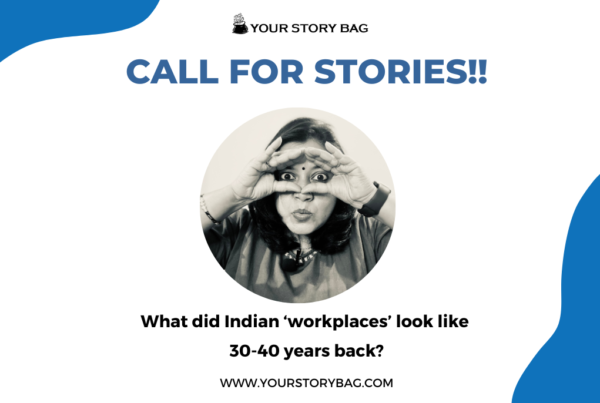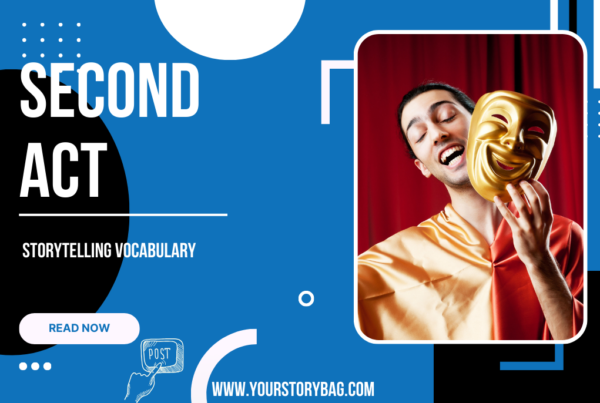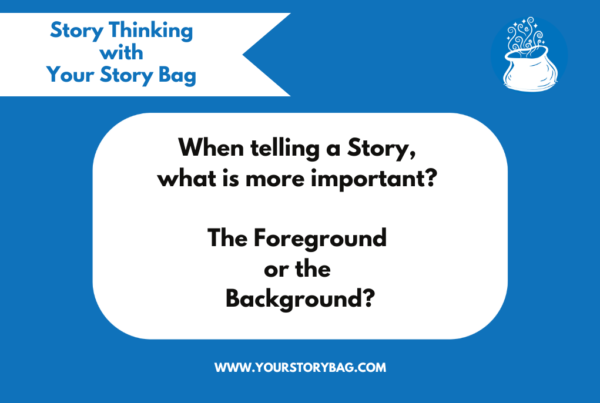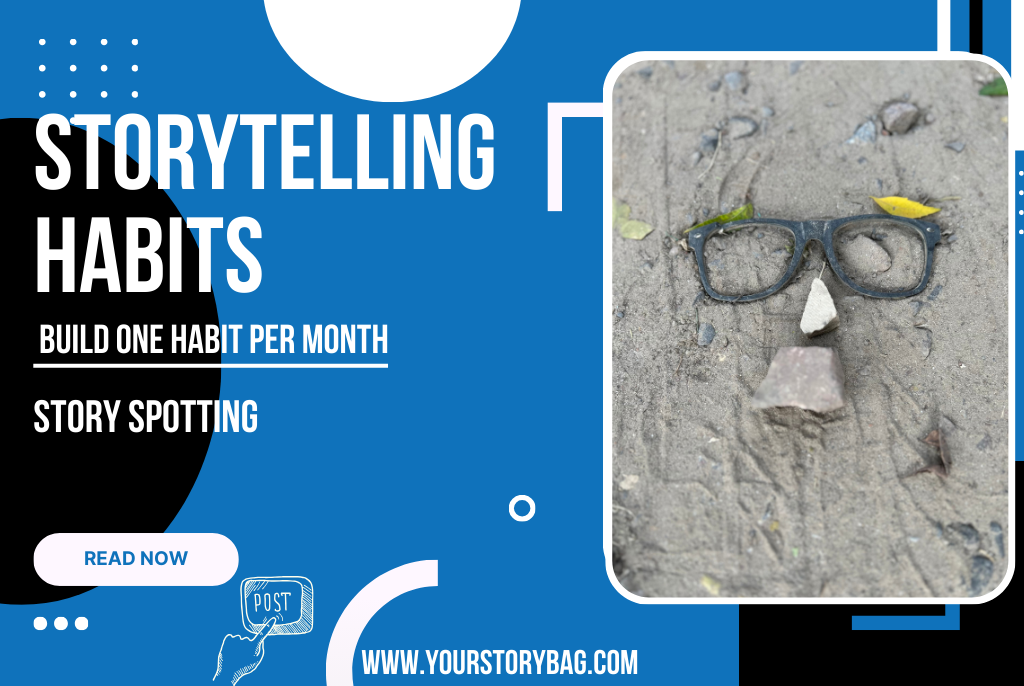
Storytelling is an ART
Storytelling is a SKILL
But, above all, Storytelling is a HABIT!
The above statements are true for me!
And if you want to acquire this skill & practice it too, start by looking at building a Storytelling Habit.
How do you build a storytelling habit?
Begin by spotting stories in your environment.
Stories are like air, we are always surrounded by them every single day. All you have to do is stop & take note of it.
Take for example, the stories of these 2 flowers…one wilted, the other one freshly plucked.
If each of these flowers could tell their own stories, what would they tell? Which one would you prefer?
(Your response to this shows the kind of story seeker you are)
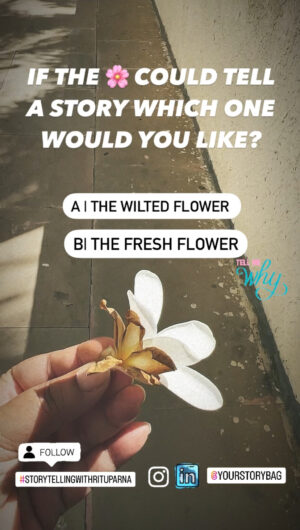
The wilted flower – The fresh flower could be a metaphor of old and new ideas! Right?
If these flowers were metaphors for your life story, which story would you tell?
(Your response to this shows the kind of storyteller you are)
Everyday as I step out to walk, I make it a point to keep an eye out for stories in my surroundings. Sometimes a fallen flower, a broken nail, a crawling bug, a crack on the wall or a splatter of water…I search for stories in everything.
I take pictures or short videos. I share only some of them through social media.
Would you like to build this Storytelling Habit too? This one also gives you stories to share!
Isn’t that cool?
How do I use them?
📍Personal journal of experiences & observations that sharpen my story saw
📍Quick analogies & metaphors as examples of stories used in social media content, training material & coaching
📍Prompts that trigger stories from my audience
📍Original Stories that I create to communicate specific ideas to my audience
Let’s take an example:
Last week during my terrace walk, I found a bunch of scattered objects across the terrace. It had rained the day before and the terrace was a mess. As I walked from one object to the other, making a mental note to have it cleaned, I slowed down. There were some fantastic metaphors waiting to be documented. Before I get the terrace cleaned, I decided to capture the valuable storytelling reminders I spotted.
Here is what I found & here is what I am making of it!
 Storytelling can feel like Walking on Eggshells
Storytelling can feel like Walking on Eggshells
You can either go right or very wrong with a story. Before you tell it, consider how will the narrative impact the listeners.
The first story that came to my mind was about the Tata Nano. Once, upon a time, I was a proud owner of a Tata Nano. The car despite the hype did not take off as Mr Tata would have wanted because he tagged it as India’s cheapest car. When he called it that, he wanted to show Tata Motors’ prowess in its engineering. However, the narrative that ran into people’s minds was that a cheap car couldn’t be good enough! The rest, as we know it, is history.
Tell a story or don’t tell it…you could land up falling into a pothole!
The broken eggshell is quite a direct representation of the idiom.
 Stories leave their Mark
Stories leave their Mark
Yes, they do. Think of the last film that moved you. Maybe it came from an ad campaign, a book, a real life encounter, or a story that someone told you at a time of need.
If you look closely you would see that some stories have left a mark in you, shaping your perspective, your thoughts and perhaps, even your actions.
This dried up water-mark was a kind reminder of the deep impact good stories leave. Of course, there is a lot of work to be done to craft those stories.
Bad stories, particularly those stemming from bad events / memories also leave a mark on a person. If you are in a position where you have to work with people, remember past failures, biases, perspectives (all shaped my lived experiences and therefore stories) can affect them.

You will need a New Story at every Step
In storytelling, there is rarely an occasion when ONE story does the job!
If you are looking at using stories to build a brand, bring a community together, drive a DEI policy, onboard new employees, build connections with donors, sponsors and investors, engage customers or convey the value of your impact, you will need a story at every step of the process.
Whatever be your goal, you will need a set of stories to impact and influence your stakeholder.
At Your Story Bag, we help clients build a robust storytelling strategy and create what we call a Story Engine.

Sometimes you need to Wipe Out Old, Stagnant and Stale Stories too!
Sometimes we get attached to a few stories. Or we get too comfortable telling them. I have fallen into this trap too. When I started telling stories, I had a favourite bunch 5-10 stories that I kept telling in the first year of my career. After a point, I realised that telling the same story was not challenging me enough. I was becoming predictable. And so, I challenged myself to tell the same story in a new way every single time. There are some stories that I no longer tell. I have better stories now and like an old cupboard of dilapidated treasures, I now have a system of refurbishing my stories every now and then. This happens to many trainers, coaches and leaders who tend to tell the same story over and over again. After a point, your stale stories would fail to be relevant. The broken wiper with half a handle was still a good tool to wipe out stagnant water. Maybe you can use it to wipe your story slate clean.
 You need an Effective Pathway for your Stories
You need an Effective Pathway for your Stories
Storytelling in organisations, businesses and non-profits usually rests in the hands of a few. Sometimes it is the entrepreneur / a charismatic leader / an enthusiastic manager / a marketeer / a communications or PR professional. However, stories (that need to be told) don’t happen before them. I have often taught communications teams the processes they need to set. For example, there is a corporate CSR that works with local NGOs to tackle issues of water, education and gender in different pockets of the country. When the CSR team has to to put out social media stories, write project reports or annual reports, they will have to go down to find the custodians of the stories. The pathway for them would be through project / program managers, their regional teams, field officers and the real subjects on the ground.
When establishing effective practices for story gathering, creating a robust channel for storytelling is essential. If you break the channel, or disrupt the flow of stories, they stop flowing from one end to the other.
 Find a Place to Store your Stories
Find a Place to Store your Stories
As you go about spotting stories in your environment, find a place to store them. Use mobile apps like Notes, Evernote, Notions, GoodNotes or similar. Make an excel sheet for stories you spot. If you spot stories in photographs, articles, newspaper / book excerpts keep a folder where you can store them. You could do all of this (as I do) or start a new small ritual of storing your everyday Small Stories in a pocket diary. Just like everything in your closet, your drawer and in your life, make room for stories so you can find the right one when you need it.
Story Spotting is an essential habit for a Storyteller.
Begin today and you will never run out of a story to tell!
Are you a Story Spotter?
🤳Use the comments below to share a story / picture that you spotted in your environment lately. Tell me how do you intend to use it in your work.
Build your Storytelling Habits is a year-long series where we share actionable steps to build ONE HABIT per month.
Subscribe to our Exclusive & Niche Newsletters
Or follow the series on our Blog
Here are the other Habits in the list:
Storytelling Habits | Story Journal
Storytelling Habits | Listening

